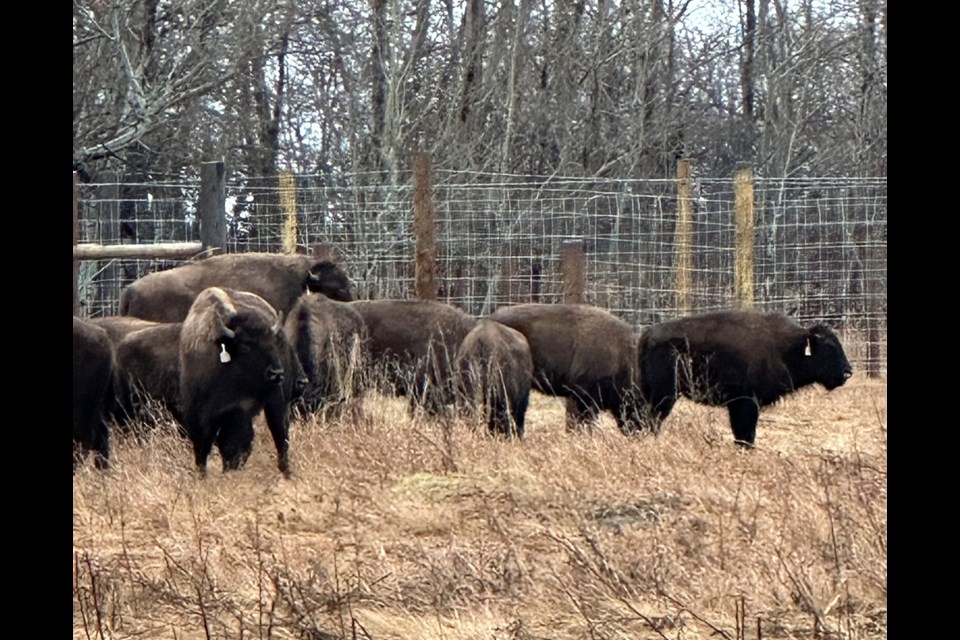Parks Canada and First Nations, Métis and Inuit are partners in conserving natural and cultural heritage, sharing the stories of these treasured places. The Government of Canada is committed to a system of national heritage places that recognizes and honours the historic and contemporary contributions of Indigenous peoples, their histories, and cultures, as well as the special relationships Indigenous peoples have with ancestral lands and waters.
Dec. 8, the Honourable Steven Guilbeault, Minister of Environment and Climate Change and Minister responsible for Parks Canada, and Michelle LeClair, Métis Nation–Saskatchewan Vice President and Minister of Environment, announced that 25 Plains bison were successfully transferred from Parks Canada to Métis Nation–Saskatchewan.
The bison were transported from Grasslands National Park to establish a new herd on MN–S lands near Batoche National Historic Site, north of Saskatoon. Eventually, the herd will be relocated to a portion of the 690 hectares of land on Batoche grounds that were transferred from Parks Canada to MN–S in July 2022.
Bison have been a cultural and historical staple for Métis people across the Homeland. Traditionally, bison provided everything from food and clothing to tools and a source of income. Métis bison or buffalo hunts were well organized bi-annual events that often involved the entire family. Parks Canada and MN–S collaborated on this bison transfer to strengthen Métis communities’ connections to their identity and land.
The return of bison to Batoche complements the long-term vision of MN–S to grow the herd and explore the economic development potential the herd will bring to the region. As stewards of the land, MN–S will also look at the educational opportunities that will be developed with youth, Elders, and community in mind.
Quotes
“Welcoming the bison back to Batoche holds enormous cultural significance for Métis people in this province. Our youth will see a tangible demonstration of Métis tradition and values as our Elders help provide invaluable land-based education. Together, we will bear witness to the growth of the herd as it reclaims the land and allows our Métis Nation government to explore the opportunities presented to us.”
Michelle LeClair
Vice President and Minister of Environment – Métis Nation– Saskatchewan
“The bison, a symbol of strength and resilience, is not only a keystone species but also a vital part of the lives of Indigenous peoples. By supporting the Métis Nation–Saskatchewan in returning bison to the landscape of Batoche, the Government of Canada is helping with this transfer that will help renew cultural, historical, and spiritual connections. This is a tangible example of the Government of Canada’s commitment to advancing reconciliation with Métis.”
The Honourable Steven Guilbeault,
Minister of Environment and Climate Change and Minister responsible for Parks Canada
Quick Facts
Over the past decade, Grasslands National Park staff have worked closely with Indigenous communities that have applied to receive bison to bring this culturally significant animal back to their traditional rangeland, while also facilitating cultural or socio-economic opportunities.
Located on the Â鶹ÊÓƵ Saskatchewan River an hour north of Saskatoon, Batoche National Historic Site commemorates the historic Métis community of Batoche, Métis river lot land use patterns, and the 1885 conflict between the Métis Provisional Government and the Government of Canada.
In 1996, the Back to Batoche festival grounds adjacent to Batoche National Historic Site, were transferred to Métis ownership and are now owned and managed by MN–S.
In 1998, Parks Canada and MN–S signed the Batoche National Historic Site Management Agreement, which provided for the creation of a Shared Management Board for the Site.
In December 2020, Parks Canada and MN–S agreed to explore and discuss a full range of options related to the future management of Batoche National Historic Site under the Framework Agreement for Advancing Reconciliation. The two parties signed the Framework Agreement on July 20, 2018, through the Recognition of Indigenous Rights and Self-Determination process.
In July 2022, Parks Canada transferred approximately 690 hectares of land situated on the west side of Batoche National Historic Site to the citizens of MN–S.
In November 2022, a Memorandum of Understanding was signed between Parks Canada and MN–S to facilitate the bison transfer. Phase one of the Memorandum of Understanding involves the reintegration of bison to Back to Batoche festival grounds near Batoche National Historic Site. Phase two will place the growing herd on a portion of the 690 hectares of land that was transferred to the citizens of MN–S in 2022.




